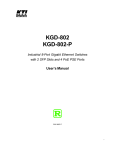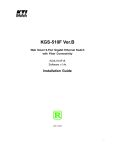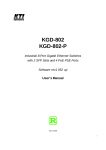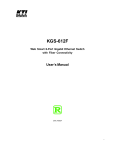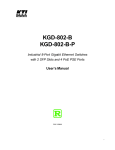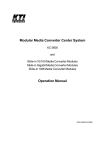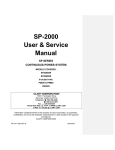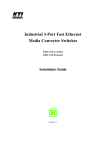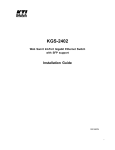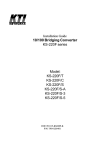Download KTI Networks Switch KGD-600 User's Manual
Transcript
KGD-600 Industrial Web Smart 6-Port Gigabit Ethernet Switch with Fiber Connectivity Installation Guide DOC.070402 -1- (C) 2006 KTI Networks Inc. All rights reserved. No part of this documentation may be reproduced in any form or by any means or used to make any directive work (such as translation or transformation) without permission from KTI Networks Inc. KTI Networks Inc. reserves the right to revise this documentation and to make changes in content from time to time without obligation on the part of KTI Networks Inc. to provide notification of such revision or change. For more information, contact: United States International KTI Networks Inc. P.O. BOX 631008 Houston, Texas 77263-1008 Phone: Fax: E-mail: URL: 713-2663891 713-2663893 [email protected] http://www.ktinet.com/ Fax: E-mail: URL: 886-2-26983873 [email protected] http://www.ktinet.com.tw/ -2- The information contained in this document is subject to change without prior notice. Copyright (C). All Rights Reserved. TRADEMARKS Ethernet is a registered trademark of Xerox Corp. WARNING: This equipment has been tested and found to comply with the limits for a Class A digital device, pursuant to Part 15 of the FCC Rules. These limits are designed to provide reasonable protection against harmful interference when the equipment is operated in a commercial environment. This equipment generates, uses, and can radiate radio frequency energy and if not installed and used in accordance with the instruction manual may cause harmful interference in which case the user will be required to correct the interference at his own expense. NOTICE: (1) The changes or modifications not expressively approved by the party responsible for compliance could void the user's authority to operate the equipment. (2) Shielded interface cables and AC power cord, if any, must be used in order to comply with the emission limits. CISPR A COMPLIANCE: This device complies with EMC directive of the European Community and meets or exceeds the following technical standard. EN 55022 - Limits and Methods of Measurement of Radio Interference Characteristics of Information Technology Equipment. This device complies with CISPR Class A. CE NOTICE Marking by the symbol indicates compliance of this equipment to the EMC directive of the Euro- pean Community. Such marking is indicative that this equipment meets or exceeds the following technical standards: EN 55022: Limits and Methods of Measurement of Radio Interference characteristics of Information Technology Equipment. EN 50082/1:Generic Immunity Standard -Part 1: Domestic Commercial and Light Industry. EN 60555-2: Disturbances in supply systems caused by household appliances and similar electrical equipment - Part 2: Harmonics. -3- Table of Contents 1. Introduction .................................................................................................. 6 1.1 1.2 1.3 1.4 Features ................................................................................................................... 7 Product Panels ......................................................................................................... 8 LED Indicators .......................................................................................................... 9 Specifications ........................................................................................................... 9 2. Installation .................................................................................................. 11 2.1 Unpacking ............................................................................................................... 11 2.2 Safety Cautions ...................................................................................................... 11 2.3 Mounting the Switch on a Wall................................................................................. 11 2.4 Din-Rail Mounting .................................................................................................... 12 2.5 Panel Mounting ........................................................................................................ 13 2.6 Applying Power ........................................................................................................ 14 2.7 Reset Button .......................................................................................................... 15 2.8 Making UTP Connections ....................................................................................... 16 2.9 Making Fiber Connection ........................................................................................ 17 2.10 LED Indication ...................................................................................................... 18 2.11 Configuring IP Address and Password for the Switch ............................................ 18 3. Advanced Functions .................................................................................. 19 3.1 Abbreviation ............................................................................................................. 19 3.2 QoS Function .......................................................................................................... 20 3.2.1 Packet Priority Classification ................................................................................ 21 3.2.2 Priority Class Queues .......................................................................................... 21 3.2.3 Egress Service Policy .......................................................................................... 21 3.3 VLAN Function ......................................................................................................... 22 3.3.1 VLAN Operation .................................................................................................... 22 3.3.2 Ingress Rules ....................................................................................................... 22 3.3.2.1 802.1Q Tag Aware Per port setting .................................................................... 22 3.3.2.2 Keep Tag Per port setting .................................................................................. 22 3.3.2.3 Drop Untag Per Port Setting .............................................................................. 23 3.3.2.4 Drop Tag Per Port Setting .................................................................................. 23 3.3.3 Ingress Default Tag Per Port Setting..................................................................... 23 3.3.4 Packet Tag Information ......................................................................................... 23 3.3.5 VLAN Group Table Configuration ........................................................................... 24 3.3.6 VLAN Classification............................................................................................... 24 3.3.7 Packet Forwarding ................................................................................................ 24 3.3.8 Egress Tagging Rules .......................................................................................... 25 3.3.8.1 Egress Settings ................................................................................................. 25 3.3.9 Summary of VLAN Function ................................................................................. 25 3.4 802.1X Authentication Port Access Control ............................................................. 26 -4- 4. Web Management ....................................................................................... 27 4.1 Start Browser Software and Making Connection ..................................................... 27 4.2 Login to the Switch Unit ........................................................................................... 27 4.3 Main Management Menu .......................................................................................... 28 4.4 System .................................................................................................................... 29 4.4.1 Management VLAN ............................................................................................... 30 4.5 Ports ........................................................................................................................ 31 4.6 VLANs ..................................................................................................................... 32 4.6.1 Port-based VLAN Mode ......................................................................................... 33 4.6.2 Port-based VLAN ISP Mode .................................................................................. 34 4.6.3 Advanced VLAN Mode ........................................................................................... 35 4.6.3.1 Ingress Default Tag ............................................................................................ 36 4.6.3.2 Ingress Settings ................................................................................................. 37 4.6.3.3 Egress Settings ................................................................................................. 38 4.6.3.4 VLAN Groups ..................................................................................................... 39 4.6.4 Important Notes for VLAN Configuration ................................................................ 40 4.7 Quality of Service .................................................................................................... 41 4.7.1 802.1p Mapping .................................................................................................... 42 4.7.2 DSCP Mapping ..................................................................................................... 43 4.7.3 QoS Service Policy .............................................................................................. 44 4.8 Port Mirroring ........................................................................................................... 45 4.9 802.1X Configuration ............................................................................................... 46 4.9.1 802.1X Re-authentication Parameters.................................................................. 47 4.10 Statistics................................................................................................................ 48 4.11 Reboot System ...................................................................................................... 49 4.12 Restore Default ..................................................................................................... 49 4.13 Update Firmware / Configuration ........................................................................... 49 4.13.1 Update Firmware ................................................................................................ 49 4.13.2 Upload Configuration File.................................................................................... 50 4.13.3 Backup Configuration File ................................................................................... 50 4.14 Logout ................................................................................................................... 50 Appendix. Factory Default Settings............................................................... 51 -5- 1. Introduction The KGD-600 is a managed 6-port Gigabit Ethernet switch which is featured with five copper ports, one mini-GBIC (SFP) port and the following advantages in a small footprint box: Plug and Play The switch is shipped with factory default configuration which behaves like an unmanaged Gigabit switch for workgroup. It provides five 10/100/1000Mbps copper ports for connections to Ethernet, Fast Ethernet, and Gigabit Ethernet devices. With the featured auto-negotiation function, the switch can detect and configure the connection speed and duplex automatically. The switch also provides auto MDI/MDI-X function, which can detect the connected cable and switch the transmission wire pair and receiving pair automatically. This auto-crossover function can simplify the type of network cables used. Fiber Connectivity The mini-GBIC (SFP) port can be installed with an optional SFP optical fiber transceiver to support one Gigabit fiber connection when needed. Web Management The switch is embedded with an Http server which provides management functions for advanced network functions including Port Control, Quality of Service, and Virtual LAN functions. The management can be performed via Web browser based interface over TCP/IP network. Virtual LAN (VLAN) For increasing Tagged VLAN applications, the switch is also featured with powerful VLAN function to fulfill the up-to-date VLAN requirements. The switch supports both port-based VLAN and tagged VLAN in per-port basis. Quality of Service For advanced application, the switch is featured with powerful Quality of Service (QoS) function which can classify the priority for received network frames based on the ingress port and frame contents. Furthermore, many service priority policies can be configured for egress operation in per-port basis. -6- Industrial Features For industrial environment, the devices are designed with the following enhanced features exceeding that of commercial Ethernet switches: • High and wide operating Temperature • Power input interface: Industrial screw terminal block and DC power jack for external commercial power adapter as option • Screw panel and DIN rail mounting support for industrial enclosure • Industrial-rated Emission and Immunity performance 1.1 Features Basic functions • • • • • • • • • Provides 5 10/100/1000Mbps Gigabit Ethernet ports and 1 SFP port Provides in-band web-based management interface All copper ports support auto-negotiation and auto-MDI/MDI-X detection Provides full wire speed forwarding Supports 802.3x flow control for full-duplex and backpressure for half-duplex Provides port status, statistic monitoring and control function Supports port-based and 802.1Q Tag-based VLAN Provides QoS function Provides port mirroring function Management functions • Web-based browsing interface • Port configuration control and status monitoring • Quality of Service (QoS) control for packet traffic • Port-based and Tagged Virtual LAN (VLAN) function • 802.1x authentication for port access control • Port mirroring function • Configuration file backup and upload • In-band embedded firmware upgrade function -7- 1.2 Product Panels The following figure illustrates the faces of the switch: -8- 1.3 LED Indicators LED Function POWER Power status LNK/1000M/ACT Network port 1000M link status (Port 1 - Port 5) LNK/100M/ACT Network port 100M link status (Port 1 - Port 5) LNK/10M/ACT Network port 10M link status (Port 1 - Port 5) P6 LNK Port 6 1000M link status P6 OL Port 6 optical link status 1.4 Specifications 10/100/1000 Copper Ports Compliance IEEE 802.3 10Base-T, IEEE 802.3u 100Base-TX, IEEE 802.3u 1000Base-T Connectors Shielded RJ-45 jacks Pin assignments Auto MDI/MDI-X detection Configuration Auto-negotiation or software control Transmission rate 10Mbps, 100Mbps, 1000Mbps Duplex support Full/Half duplex Network cable Cat.5 UTP 1000Mbps Mini-GBIC Fiber Port Compliance IEEE 802.3z 1000Base-SX/LX (mini-GBIC) Connectors SFP for optional SFP type fiber transceivers Configuration Auto/Forced, 1000Mbps, Full duplex Transmission rate 1000Mbps Network cables MMF 50/125 60/125, SMF 9/125 Eye safety IEC 825 compliant Switch Functions MAC Addresses Table 8K entries Forwarding & filtering Non-blocking, full wire speed Switching technology Store and forward Maximum packet length 1526 bytes Flow control IEEE 802.3x pause frame base for full duplex operation Back pressure for half duplex operation VLAN function Port-based VLAN and IEEE 802.1Q Tag-based VLAN QoS function Port-based, 802.1p-based, IP DSCP-based -9- Port control Port configuration control via software management Port Mirroring Mirror received frames to a sniffer port Software Management Functions Interfaces Web browser Management objects System configuration - IP settings, Name, Password Port configuration control and status VLAN function settings QoS function settings Port mirroring settings 802.1x authentication port-access control Port Statistic Reboot, restore factory default, update firmware DC Power Input Interfaces DC IN Jack ( -D 6.3mm / + D 2.0mm) DC IN Terminal Block - screw type Operating Input Voltages +5 ~ 30VDC(+/-5%) Power Consumption 3.6W max. @7.5V Mechanical Dimension (base) 144 x 104.5 x 26 mm Housing Enclosed metal with no fan Mounting Support Din-rail mounting, Panel mounting, Wall mounting, Desktop mounting Environmental Operating Temperature Typical -20oC ~ 70oC Storage Temperature -20oC ~ 85oC Relative Humidity 10% ~ 90% Special Test NEMA TS2-2003 Environment: Endurance Vibration, Mechanical shock test, Temperature/Humidity test (Condition combination : -34oC ~ +74oC, 0 ~90%RH, +5 ~ +30VDC) Electrical Approvals FCC Part 15 rule Class A CE EMC, CISPR22 Class A Safety IEC60950-1 / EN60950 -10- 2. Installation 2.1 Unpacking The product package contains: • The switch unit • One product CD-ROM 2.2 Safety Cautions To reduce the risk of bodily injury, electrical shock, fire, and damage to the product, observe the following precautions. • Do not service any product except as explained in your system documentation. • Opening or removing covers may expose you to electrical shock. • Only a trained service technician should service components inside these compartments. • If any of the following conditions occur, unplug the product from the electrical outlet and replace the part or contact your trained service provider: - The power cable, extension cable, or plug is damaged. - An object has fallen into the product. - The product has been exposed to water. - The product has been dropped or damaged. - The product does not operate correctly when you follow the operating instructions. • Do not push any objects into the openings of your system. Doing so can cause fire or electric shock by shorting out interior components. • Operate the product only from the type of external power source indicated on the electrical ratings label. If you are not sure of the type of power source required, consult your service provider or local power company. 2.3 Mounting the Switch on a Wall The switch can be mounted on a desktop or shelf or a wall. Make sure that there is proper heat dissipation from and adequate ventilation around the device. Do not place heavy objects on the device. -11- 2.4 Din-Rail Mounting The steps to mount the switch on a Din-rail are: One Din-rail mounting bracket is provided in the product package as shown below: Install the bracket on the bottom of the switch unit. Mount the device on a Din-rail. -12- 2.5 Panel Mounting One panel mounting bracket is provided in the product package as shown below: Install the bracket on the bottom of the switch unit. The final dimension after panel bracket is installed is shown below: -13- 2.6 Applying Power The switch provides two types of power interfaces, terminal block and DC power jack for receiving DC power input from external power supply system. Using Terminal Blocks Three terminal contacts are provided: Vdc Positive (+) terminal Vdc Negative (-) terminal Chassis ground ( Vdc : +5V ~ +30VDC) One 3P terminal plugs are provided together with the switch. The plug is shown below: Power wires : 24 ~ 12AWG (IEC 0.5~2.5mm2) Install the power source wires with the plug properly. Then, plug in the terminal block socket. -14- Using DC Power Jack When an external power system is not available, the switch provides a DC jack to receive power from typical AC-DC power adapter alternatively. AC Power Adapters: Optional commercial rated adapters are available for purchasing. AC input power: AC power voltage of your area, options Rated AC120V/60Hz DC7.5V 1A Rated AC230V/50Hz DC7.5V 1A Rated AC100V/50-60Hz DC7.5V 1A Rated AC100V/50-60Hz DC5V 1A Rated AC240V/50Hz DC7.5V 1A Note: Before you begin the installation, check the AC voltage of your area. The AC power adapter which is used to supply the DC power for the unit should have the AC voltage matching the commercial power voltage in your area. 2.7 Reset Button The reset button is used to perform a reset to the switch. It is not used in normal cases and can be used for diagnostic purpose. If any network hanging problem is suspected, it is useful to push the button to reset the switch without turning off the power. Check whether the network is recovered. The button can also be used to restore the software configuration settings to factory default values. The operations are: Operation Function Press the button more than 5 seconds when power up Press the button and release during switch operation Restore factory default settings Reboot the switch -15- 2.8 Making UTP Connections The 10/100/1000 copper ports support the following connection types and distances: Network Cables 10BASE-T: 2-pair UTP Cat. 3,4,5 , EIA/TIA-568B 100-ohm 100BASE-TX: 2-pair UTP Cat. 5, EIA/TIA-568B 100-ohm 1000BASE-T: 4-pair UTP Cat. 5 or higher (Cat.5e is recommended), EIA/TIA-568B 100-ohm Link distance: Up to 100 meters Auto MDI/MDI-X Function This function allows the port to auto-detect the twisted-pair signals and adapts itself to form a valid MDI to MDI-X connection with the remote connected device automatically. No matter a straight through cable or crossover cable is connected, the ports can sense the receiving pair automatically and configure itself to match the rule for MDI to MDI-X connection. It simplifies the cable installation. Auto-negotiation Function The ports are featured with auto-negotiation function and full capability to support connection to any Ethernet devices. The port performs a negotiation process for the speed and duplex configuration with the connected device automatically when each time a link is being established. If the connected device is also auto-negotiation capable, both devices will come out the best configuration after negotiation process. If the connected device is incapable in auto-negotiation, the switch will sense the speed and use half duplex for the connection. Port Configuration Management For making proper connection to an auto-negotiation incapable device, it is suggested to use port control function via software management to set forced mode and specify speed and duplex mode which match the configuration used by the connected device. -16- 2.9 Making Fiber Connection The mini-GBIC (SFP) port must be installed with an SFP fiber transceiver for making fiber connection. Your switch may come with an SFP transceiver pre-installed when it is shipped. Installing SFP Fiber Transceiver To install an SFP fiber transceiver into mini-GBIC port, the steps are: 1. Turn off the power to the switch. 2. Insert the SFP fiber transceiver into the mini-GBIC port. Normally, a bail is provided for every SFP transceiver. Hold the bail and make insertion. 3. Until the SFP transceiver is seated securely in the slot, place the bail in lock position. Connecting Fiber Cables LC connectors are commonly equipped on most SFP transceiver modules. Identify TX and RX connector before making cable connection. The following figure illustrates a connection example between two fiber ports: Make sure the Rx-to-Tx connection rule is followed on the both ends of the fiber cable. Network Cables Multimode (MMF) - 50/125, 62.5/125 Single mode (SMF) - 9/125 -17- 2.10 LED Indication LED Function State Interpretation POWER Power status ON OFF The power is supplied to the switch. The power is not supplied to the switch. LNK/1000M/ACT Port link status ON A 1000M link is established. (No traffic) BLINK Port link is up and there is traffic. OFF Port link is down. LNK/100M/ACT Port link status ON A 100M link is established. (No traffic) BLINK Port link is up and there is traffic. OFF Port link is down. LNK/1000M/ACT Port link status ON A 10M link is established. (No traffic) BLINK Port link is up and there is traffic. OFF Port link is down. P6 LNK Port6 link status ON A 1000M link is established on Port 6. BLINK Port 6 link is up and there is traffic. OFF Port 6 link is down. P6 OL Port6 optical link ON OFF Optical signal is detected on Port 6. No optical signal is detected on Port 6. 2.11 Configuring IP Address and Password for the Switch The switch is shipped with the following factory default settings for software management : Default IP address of the switch : 192.168.0.2 / 255.255.255.0 The IP Address is an identification of the switch in a TCP/IP network. Each switch should be designated a new and unique IP address in the network. Refer to Web management interface for System Configuration. The switch is shipped with factory default password 123 for software management. The password is used for authentication in accessing to the switch via Http web-based interface. For security reason, it is recommended to change the default settings for the switch before deploying it to your network. Refer to Web management interface for System Configuration. -18- 3. Advanced Functions To help a better understanding about the software management interfaces, this chapter describes some advanced functions provided by the switch. 3.1 Abbreviation Ingress Port : Ingress port is the input port on which a packet is received. Egress Port : Egress port is the output port from which a packet is sent out. IEEE 802.1Q Packets : A packet which is embedded with a VLAN Tag field VLAN Tag : In IEEE 802.1Q packet format, 4-byte tag field is inserted in the original Ethernet frame between the Source Address and Type/Length fields. The tag is composed of : #of bits Frame field 16 TPID 3 User priority 1 CFI 12 VID TPID : 16-bit field is set to 0x8100 to identify a frame as an IEEE 802.1Q tagged packet User Priority : 3-bit field refer to the 802.1p priority CFI : The Canonical Format Indicator for the MAC address is a 1 bit field. VID : VLAN identifier, 12-bit field identifies the VLAN to which the frame belongs to. Untagged packet : A standard Ethernet frame with no VLAN Tag field Priority-tagged packet : An IEEE 802.1Q packet which VID filed value is zero (VID=0) VLAN-Tagged packet : An IEEE 802.1Q packet which VID filed value is not zero (VID<>0) PVID (Port VID) PVID is the default VID of an ingress port. It is often used in VLAN classification for untagged packets. It is also often used for egress tagging operation. DSCP : Differentiated Service Code Point, 6-bit value field in an IP packet VLAN Table lookup : The process of searching VLAN table to find a VLAN which matches the given VID index MAC address table lookup : The process of searching MAC address table to find a MAC entry which matches the given destination MAC address and the port where the MAC address is located Packet forwarding : also known as packet switching in a network switch based on MAC address table and VLAN table information VLAN forwarding : the operation that a packet is forwarded to an egress destination port based on VLAN table information VLAN group : configuration information about a VLAN which can be recognized in the switch. The information includes a VID associated to the VLAN, member ports, and some special settings. -19- 3.2 QoS Function The switch provides a powerful Quality of Service (QoS) function to guide the packet forwarding in four priority classes. The versatile classification methods can meet most of the application needs. The following figure illustrates the QoS operation flow when a packet received on the ingress port until it is transmitted out from the egress port: -20- 3.2.1 Packet Priority Classification Each received packet is examined and classified into one of four priority classes, Class 3, Class 2, Class 1 and Class 0 upon reception. The switch provides the following classification methods: 802.1p classification : use User Priority tag value in the received IEEE 802.1Q packet to map to one priority class DSCP classification : use DSCP value in the received IP packet to map to one priority class Port-based classification : used when 802.1p and DSCP are disabled or fail to be applied They all can be configured to be activated or not. More than one classification methods can be enabled at the same time. However, 802.1p classification is superior than DSCP classification. 802.1p mapping tables : Each ingress port has its own mapping table for 802.1p classification. DSCP mapping table : All ingress ports share one DSCP mapping table for DSCP classification. Default port priority : A port default priority class is used when port-based classification is applied All configuration settings are in per port basis except that DSCP mapping table is global to all ports. A received packet is classified into one of four priority class before it is forwarded to an egress port. 3.2.2 Priority Class Queues Each egress port in the switch is equipped with four priority class egress queues to store the packets for transmission. A packet is stored into the class queue which is associated to the classified priority class. For example, a packet is stored into Class 3 egress queue if it is classified as priority Class 3. 3.2.3 Egress Service Policy Each port can be configured with an egress service policy to determine the transmission priority among four class queues. By default, higher class number has higher priority than the lower class numbers. Four policies are provided for selection as follows: • • • • Strict priority : Packets in high priority class queue are sent first until the queue is empty Weighted ratio priority Class 3:2:1:0 = 4:3:2:1 : four queues are served in 4:3:2:1 ratio Weighted ratio priority Class 3:2:1:0 = 5:3:1:1 : four queues are served in 5:3:1:1 ratio Weighted ratio priority Class 3:2:1:0 = 1:1:1:1 : four queues are served equally Strict priority policy lets high priority class queue is served first until it is empty. Lower priority queue may not get any service (or egress bandwidth) when higher priority traffic is heavy for long time. Three weighted ratio policies are provided to resolve such problem. Four class queues are served in weighted round robin basis. Every priority class can get a guaranteed ratio for the egress bandwidth. -21- 3.3 VLAN Function The switch supports port-based VLAN, 802.1Q Tag VLAN and eight VLAN groups. 3.3.1 VLAN Operation The following figure illustrates the basic VLAN operation flow beginning from a packet received on an ingress port until it is transmitted from an egress port. The following sections describe the VLAN processes and Advanced VLAN mode settings provided by the switch. A global setting means the setting is applied to all ports of the switch. A per port setting means each port can be configured for the setting respectively. 3.3.2 Ingress Rules When a packet is received on an ingress port, the ingress rules are applied for packet filtering and packet tag removal. The related Ingress port settings are: 3.3.2.1 802.1Q Tag Aware Per port setting Tag-aware -802.1Q Tag Aware mode is used. The switch examines the tag content of every received packets. For a VLAN tagged packet, the packet VLAN tag data is retrieved as packet tag information for VLAN classification and egress tagging operation. For untagged packet and priority-tagged packet, port-based mode is used. Tag-ignore - Port-based mode is used. The switch ignores the tag content of every received packets. Ingress Port Default Tag is always used as packet tag information for VLAN classification. 3.3.2.2 Keep Tag Per port setting Enable - The VLAN tag in the received VLAN tagged packet will be kept as it is and is not stripped in whole forwarding operation. Disable - The VLAN tag data in the received VLAN tagged packet is stripped (removed). -22- 3.3.2.3 Drop Untag Per Port Setting Enable - All untagged packets and priority-tagged packets are dropped. A priority-tagged packet is treated as an untagged packet in this switch. Only VLAN-tagged packets are admitted. Disable - Disable Untagged packet filtering 3.3.2.4 Drop Tag Per Port Setting Enable - All VLAN-tagged packets are dropped. A priority-tagged packet is treated as an untagged packet in this switch. Only untagged packets are admitted. Disable - Disable VLAN-tagged packet filtering 3.3.3 Ingress Default Tag Per Port Setting Each port can be configured with one Ingress Default Tag. This ingress port default tag is used when ingress port is in Tag-ignore mode or for the received untagged packets in Tag-aware mode. The Ingress Default Tag includes PVID, CFI and User Priority configuration. When Ingress port default tag is used, it is copied as packet associated Packet Tag Information for VLAN classification. The PVID is used as index to one VLAN group in VLAN group table. 3.3.4 Packet Tag Information Under VLAN process, every packet is associated with one Packet Tag information in packet forwarding operation. The tag information includes VID, CFI and User Priority data and is used for two purposes: • The VID in tag is used as index for VLAN classification. • The tag is used for egress tag insertion if egress tagging is enabled. The following table lists how the Packet Tag information is generated: Tag Aware setting Tag-ignore Tag-ignore Tag-ignore Tag-aware Tag-aware Tag-aware Received Packet Type Untagged packet Priority-tagged packet VLAN-tagged packet Untagged packet Priority-tagged packet VLAN-tagged packet -23- Packet Tag information source Ingress Port Default Tag Ingress Port Default Tag Ingress Port Default Tag Ingress Port Default Tag Ingress Port Default Tag Received packet VLAN Tag 3.3.5 VLAN Group Table Configuration The switch provides a table of eight VLAN groups to support up to eight VLANs at the same time. Each VLAN group is associated to one unique VLAN. The table is referred for VLAN classification. A VLAN group contains the following configuration settings: VID : 12-bit VLAN Identifier index to the VLAN to which the group is associated Member Ports : the admitted egress ports for packets belonging to this VLAN Source Port Check : the ingress port of the packet must also be the member port of this VLAN. Otherwise, the packet is discarded. 3.3.6 VLAN Classification VLAN classification is a process to classify a VLAN group to which a received packet belongs. The VID of the generated Packet Tag information associated to the received packet is used as an index for VLAN group table lookup. The VID matched VLAN group will be used for packet forwarding. If no matched VLAN group is found in table lookup, the packet is dropped. Refer to section 3.2.4 for details about how the Packet Tag information is generated. The member ports specified in the matched VLAN group are the admitted egress port range for the packet. The packet will never be forwarded to other ports which are not in the member ports. The Source Port Check setting of the matched VLAN group is also referred. If it is enabled, the ingress port will be checked whether it is a member port of this group. 3.3.7 Packet Forwarding The forwarding is a process to forward the received packet to one or more egress ports. The process uses the following information as forwarding decision: • • • • Member ports of the matched VLAN group : the egress port range for forwarding Source Port Check setting of the matched VLAN group : check ingress port membership The packet destination MAC address : for MAC address table loop up The switch MAC address table : to find the associated port where a MAC address is learned If the MAC address table lookup is matched and the learned port is the VLAN member port, the packet is forwarded to the port (egress port). If the lookup failed, the switch will broadcast the packet to all member ports. -24- 3.3.8 Egress Tagging Rules Egress Tagging rules are used to make change to the packet before it is stored into egress queue of an egress port. Three egress settings are provided for each port and are described as follows: 3.3.8.1 Egress Settings Insert Tag (per port setting) Enable Insert the Tag data of the associated Packet Tag information into the packet Disable - No tagging is performed. Untagging Specific VID (per port setting) Enable No tag insertion if the VID data of the associated Packet Tag information matches the Untagged VID configured in next setting even [Insert Tag] is enabled. Disable - This rule is not applied. 3.3.9 Summary of VLAN Function VLAN Modes Port-based VLAN Mode : simple port-based 2-VLAN-groups mode Port-based VLAN ISP Mode : simple port-based 5-VLAN-groups mode Advanced VLAN Mode : Full VLAN configuration for port-based and Tag-based VLAN Advanced VLAN Mode Egress Settings (per port) : [Tag Aware], [Keep Tag], [Drop Untag], [Drop Tag] Ingress Default Tag (per port) : [PVID], [CFI], [User Priority] VLAN Groups (global) : 8 VLAN groups VLAN Group Settings (per group) : [VID], [Member Ports], [Source Port Check] Egress Settings : [Insert Tag], [Untagging Specific VID], [Untagged VID] VLAN range supported : 1 ~ 4095 (eight VLANs at the same time) [PVID] [VID] [Untagged VID] value range : 1 ~ 4095 -25- 3.4 802.1X Authentication Port Access Control For some IEEE 802 LAN environments, it is desirable to restrict access to the services offered by the LAN to those users and devices that are permitted to make use of those services. IEEE 802.1X Portbased network access control function provide a means of authenticating and authorizing devices attached to a LAN port that has point-to-point connection characteristics, and of preventing access to that port in cases in which the authentication and authorization process fails. The 802.1X standard relies on the client to provide credentials in order to gain access to the network. The credentials are not based on a hardware address. Instead, they can be either a username/password combination or a certificate. The credentials are not verified by the switch but are sent to a Remote Authentication Dial-In User Service (RADIUS) server, which maintains a database of authentication information. 802.1X consists of three components for authentication exchange, which are as follows: • An 802.1X authenticator: This is the port on the switch that has services to offer to an end device, provided the device supplies the proper credentials. • An 802.1X supplicant: This is the end device; for example, a PC that connects to a switch that is requesting to use the services (port) of the device. The 802.1X supplicant must be able to respond to communicate. • An 802.1X authentication server: This is a RADIUS server that examines the credentials provided to the authenticator from the supplicant and provides the authentication service. The authentication server is responsible for letting the authenticator know if services should be granted. The 802.1X authenticator operates as a go-between with the supplicant and the authentication server to provide services to the network. When a switch is configured as an authenticator, the ports of the switch must then be configured for authorization. In an authenticator-initiated port authorization, a client is powered up or plugs into the port, and the authenticator port sends an Extensible Authentication Protocol (EAP) PDU to the supplicant requesting the identification of the supplicant. At this point in the process, the port on the switch is connected from a physical standpoint; however, the 802.1X process has not authorized the port and no frames are passed from the port on the supplicant into the switching engine. If the PC attached to the switch did not understand the EAP PDU that it was receiving from the switch, it would not be able to send an ID and the port would remain unauthorized. In this state, the port would never pass any user traffic and would be as good as disabled. If the client PC is running the 802.1X EAP, it would respond to the request with its configured ID. (This could be a username/ password combination or a certificate.) After the switch, the authenticator receives the ID from the PC (the supplicant). The switch then passes the ID information to an authentication server (RADIUS server) that can verify the identification information. The RADIUS server responds to the switch with either a success or failure message. If the response is a success, the port will be authorized and user traffic will be allowed to pass through the port like any switch port connected to an access device. If the response is a failure, the port will remain unauthorized and, therefore, unused. If there is no response from the server, the port will also remain unauthorized and will not pass any traffic. -26- 4. Web Management The switch features an http server which can serve the management requests coming from any web browser software over TCP/IP network. Web Browser Compatible web browser software with JAVA script support Microsoft Internet Explorer 4.0 or later Netscape Communicator 4.x or later Set IP Address for the System Unit Before the switch can be managed from a web browser software, make sure a unique IP address is configured for the switch. 4.1 Start Browser Software and Making Connection Start your browser software and enter the IP address of the switch unit to which you want to connect. The IP address is used as URL for the browser software to search the device. URL : http://xxx.xxx.xxx.xxx/ Factory default IP address : 192.168.0.2 4.2 Login to the Switch Unit When browser software connects to the switch unit successfully, a Login screen is provided for you to login to the device as follows: The switch will accept only one successful management connection at the same time. The other connection attempts will be prompted with a warning message. A new connection will be accepted when the current user logout successfully or auto logout by the switch due to no access for time out of 3 minutes. System Configuration is displayed after a successful login. -27- 4.3 Main Management Menu The following information describes the basic functions of the main menu. Configuration System Switch information, system and IP related settings Ports Port link status, port operation mode configuration VLAN VLAN related configuration QoS Quality of Service related configuration Port Mirroring Port mirroring related configuration 802.1X 802.1x authentication for port access control Monitoring Statistics List statistics for all ports Maintenance Reboot System Command to reboot the switch Restore Default Command to restore the switch with factory default settings Update Firmware Command to update the switch firmware, Command to update the switch configuration (upload file) Command to backup configuration file to your PC Logout Command to logout from the switch management -28- 4.4 System Configuration Description MAC Address The MAC address factory configured for the switch It can not be changed in any cases. S/W Version The firmware version currently running H/W Version The hardware version currently operating Management VLAN - VID - CFI - User priority Set management VLAN information VLAN ID configured for web management to the switch CFI value for web reply packets from the switch Priority value for web reply packets from the switch IP Address Set IP address for the switch management Subnet Mask Set Subnet mask for IP address for the switch management Gateway Set Default gateway IP address for the switch management Name Set the system name for this switch unit Password Set new password [Apply] Click to apply the configuration change [Refresh] Click to refresh current configuration Note: It is suggested to give each switch unit a system name as an alternative unique identification beside IP address. -29- 4.4.1 Management VLAN Management VLAN settings allow administrator to access the switch and perform the switch management over a dedicated VLAN. The following rules are applied with the Management VLAN: 1. If the VLAN function is disabled, Management VLAN settings are ignored and no VLAN limitation is applied in accessing the switch web management interface. The switch web (http) server only accepts untagged management packets and replies untagged packets to the management host. 2. If [Management VLAN - VID] settings is zero, no VLAN limitation is applied in accessing the switch web management interface. The switch web (http) server only accepts untagged management packets and replies untagged packets to the management host. 3. If [Management VLAN - VID] settings is not zero, The switch web (http) server only accepts tagged management packets matched [Management VLAN -VID] and replies tagged packets with tag composed of [Management VLAN] VID, CFI and User Priority settings to the management host. The egress port will also be limited in the member ports of the matched VLAN group. Summary of the rules: VLAN Configuration Management VLAN VID VLAN disabled Ignore VLAN enabled VID=0 VLAN enabled VID<>0 ( 1 ~ 4095) Switch Embedded Web Server operation Accept untagged web packets Reply untagged packets No VLAN group member checking Accept untagged web packets Reply untagged packets No VLAN group member checking Accept matched tagged web packets only Reply tagged packets with the configured tag Matched VLAN group member checking Notes: 1. To apply management VLAN function, be sure to configure a VLAN group that matches the management VID first. 2. No matter how management VLAN is configured, login password authentication is still required. -30- 4.5 Ports Configuration Function Port The port number Link Port link status Speed and duplex status with green background - port is link on Down with red background - port is link down Mode Select port operating mode Disabled - disable the port operation Port 1 - Port 5 Mode Auto-negotiation Auto Enable 10 Half Disable 10 Full Disable 100 Half Disable 100 Full Disable 1000 Full Enable Speed capability 10, 100, 1000M 10M 10M 100M 100M 1000M Port 6 Mode Auto-negotiation 1000 Full Enable Force 1000 Full Disable Duplex capability Full, Half Half Full Half Full Full Speed capability 1000M 1000M Duplex capability Full Full Flow Control Set port flow control function V - set to enable 802.3x pause flow control for ingress and egress [Apply] Click to apply the configuration change [Refresh] Click to refresh current configuration -31- 4.6 VLANs VLAN Configuration Description VLAN Disable Select to disable VLAN function All ports are allowed to communicate with each others freely with no VLAN limitation. Port-based VLAN Mode Simple configuration for 2 port-based VLAN groups Port-based VLAN ISP Mode Simple configuration for 5 port-based VLAN groups Advance VLAN Mode Full VLAN configuration for port-based and Tag-based VLAN [Apply] Click to apply the configuration change [Refresh] Click to refresh current configuration -32- 4.6.1 Port-based VLAN Mode Configuration Description Group 1, 2 Port-based VLAN group number Member ports Select member ports for the group [Apply] Click to apply the configuration change [Refresh] Click to refresh current configuration [Back] Click to go back to upper menu Operation in this mode: 1. The member ports of two groups are allowed to overlap. 2. The member ports in same group can communicate with other members only. 3. No packet tag is examined. 4. A received packet will not be modified (i.e. tagging or untagging) through VLAN operation till it is transmitted. -33- 4.6.2 Port-based VLAN ISP Mode Configuration Description Joint port Select a port as the joint port for all 5 port-based VLAN groups [Apply] Click to apply the configuration change [Refresh] Click to refresh current configuration [Back] Click to go back to upper menu Example: If Port 6 is selected as the joint port, the 5 port-based VLAN groups are configured as follows automatically: Group 1 - member [Port 1, Port 6] Group 2 - member [Port 2, Port 6] Group 3 - member [Port 3, Port 6] Group 4 - member [Port 4, Port 6] Group 5 - member [Port 5, Port 6] Mode Operation : 1. The joint port is the shared member port for all groups. 2. Two member ports are configured in each group. 3. The member ports in same group can communicate with other only. 4. No packet tag is examined. 5. A received packet will not be modified (i.e. tagging or untagging) through VLAN operation till it is transmitted. -34- 4.6.3 Advanced VLAN Mode Configuration Description Ingress Default Tag Click to configure per port Ingress Default Tag settings Ingress Settings Click to configure per port ingress settings Egress Settings Click to configure per port egress settings VLAN Groups Click to configure VLAN group table -35- 4.6.3.1 Ingress Default Tag Configuration Description Port Port number PVID Port VID, VID for Ingress Default Tag 1 ~ 4095 - decimal 12-bit VID value CFI CFI for Ingress Default Tag 0, 1 - 1-bit CFI value User Priority User priority for Ingress Default Tag 0 ~ 7 - decimal 3-bit value [Apply] Click to apply the configuration change [Refresh] Click to refresh current configuration [Back] Click to go back to upper menu PVID is used as index for VLAN classification (VLAN group table lookup) in one of the following conditions: 1. Ingress port [Tag Aware] setting = Tag-ignore 2. Ingress port [Tag Aware] setting = Tag-aware and the received packet is untagged or priority-tagged [PVID+CFI+User Priority] = Ingress Default Tag for the ingress port It is used as the tag for insertion in egress tagging operation in one of the following conditions: 1. Ingress port [Tag Aware] setting = Tag-ignore, Egress port [Insert Tag] = Enable 2. Ingress port [Tag Aware] setting = Tag-aware, Egress port [Insert Tag] = Enable and the received packet is untagged or priority-tagged -36- 4.6.3.2 Ingress Settings Configuration Description Port Port number Tag Aware Check tag data for every received packet Tag-aware - set to activate Tag-based mode Tag-ignore - set to use port-based mode and ignore any tag in packet Keep Tag Tag is removed from the received packet if exists Enable - set to activate tag removal for VLAN-tagged packets Disable - set to disable tag removal function Drop Untag Drop all untagged packets and priority-tagged packets Enable - drop untagged packets and priority-tagged packets Disable - admit untagged packets and priority-tagged packets Drop Tag Drop all VLAN-tagged packets Enable - drop VLAN-tagged packets Disable - admit VLAN-tagged packets [Apply] Click to apply the configuration change [Refresh] Click to refresh current configuration [Back] Click to go back to upper menu Note: 1. Priority-tagged packet (VID=0) is treated as untagged packet in the switch. 2. [Tag Aware] setting affects the index used for VLAN classification (VLAN table lookup). The following table lists the index used: Received packet type Untagged Priority-tagged (VID=0) VLAN-tagged (VID>0) Ingress [Tag Aware] setting Tag-ignore Tag-aware PVID PVID PVID PVID PVID Packet tag VID 3. Both [Drop Untag] and [Drop Tag] are set to Disable to admit all packets. -37- 4.6.3.3 Egress Settings Configuration Description Port Port number Insert Tag Activate tagging (Insert a tag to the packet) Enable - set to activate tagging Disable - set to disable tagging function Untagging Specific VID No tagging if VID of packet tag information matches [Untagged VID] Enable - set to enable this function Disable - set to disable this function Untagged VID VID for [Untagging Specific VID] setting 1 ~ 4095 - decimal 12-bit VID value [Apply] Click to apply the configuration change [Refresh] Click to refresh current configuration [Back] Click to go back to upper menu The inserted tag sources when [Insert Tag] = Enable are listed as follows: Received packet type Untagged Priority-tagged (VID=0) VLAN-tagged (VID>0) [Tag Aware]=Tag-ignore Ingress Default Tag Ingress Default Tag Ingress Default Tag -38- [Tag Aware]=Tag-aware Ingress Default Tag Ingress Default Tag Packet own tag 4.6.3.4 VLAN Groups Configuration Description Group Group number VID VID of the VLAN to which this group is associated 1 ~ 4095 - decimal 12-bit VID value Member Ports Select the admitted egress ports for the packets belong to the VLAN Port 1 ~ 6 - click to select Source Port Check Check whether the ingress port is the member port of the VLAN Enable - set to enable this check, the packet is dropped if ingress port is not member port of the VLAN. Disable - set to disable this check [Apply] Click to apply the configuration change [Refresh] Click to refresh current configuration [Back] Click to go back to upper menu -39- 4.6.4 Important Notes for VLAN Configuration Some considerations should be checked in configuring VLAN settings: 1. Switch VLAN Mode selection It is suggested to evaluate your VLAN application first and plan your VLAN configuration carefully before applying it. Any incorrect setting might cause network problem. 2. Double Tagged in Advanced VLAN Mode For a received packet, Ingress port [Keep Tag] setting and Egress port [Insert Tag] setting are enabled at the same time. It will cause the packet double-tagged when egress. Although, it is often applied in Q-in-Q provider bridging application. However, such condition should be avoided in normal VLAN configuration. See table below: Ingress port Egress port [Keep Tag] [Insert Tag] Enable Enable Enable Enable Received Packet Priority-tagged VLAN-tagged -40- Packet Transmitted Double-tagged Double-tagged 4.7 Quality of Service QoS Configuration Description Port Port number 802.1p 802.1p priority classification Enable - set to enable this classification to the port for priority-tagged and VLAN-tagged packets Disable - 802.1p classification is not applied to the port DSCP DSCP classification Enable - set to enable DSCP classification to the port for IP packets Disable - DSCP classification is not applied to the port Port Priority Port default priority class, it is used as a port-based QoS mode when 802.1p and DSCP classifications are disabled. It is also used as default priority class for the received packet when both 802.1p and DSCP classification failed in classification. Class 3 ~ Class 0 - priority class [802.1p Mapping] Click to configure 802.1p mapping tables. [DSCP Mapping] Click to configure DSCP mapping table. [Service Policy] Click to configure per port egress service policy mode. [Apply] Click to apply the configuration change [Refresh] Click to refresh current configuration Note: 802.1p classification is superior over DSCP classification if both are enabled. That means if a received packet is classified successfully in 802.1p classification, the classified priority class is used directly for the packet and the result of DSCP classification is ignored. -41- 4.7.1 802.1p Mapping Configuration Description Port n Port number n tag m 3-bit User priority tag value m ( range : 0 ~ 7 ) Priority class Mapped priority class for tag m on Port n Class 3 ~ Class 0 [Apply] Click to apply the configuration change [Refresh] Click to refresh current configuration [Back] Click to go back to upper menu Every ingress port has its own 802.1p mapping table. The table is referred in 802.1p priority classification for the received packet. -42- 4.7.2 DSCP Mapping Configuration Description DSCP [0-63] Seven user-defined DSCP values which are configured with a priority class 0 ~ 63 - 6-bit DSCP value in decimal Priority The priority class configured for the user-defined DSCP value Class 3 ~ Class 0 All others The other DSCP values not in the seven user-defined values are assigned a default priority class Class 3 ~ Class 0 [Apply] Click to apply the configuration change [Refresh] Click to refresh current configuration [Back] Click to go back to upper menu Only one DSCP mapping table is configured and applied to all ports. The table is referred in DSCP priority classification. -43- 4.7.3 QoS Service Policy Configuration Description Port Port number Policy Service policy for egress priority among four egress class queues Strict priority - high class queue is served first always till it is empty Weighted ratio priority Class 3:2:1:0 = 4:3:2:1 - weighted ratio 4:3:2:1 Weighted ratio priority Class 3:2:1:0 = 5:3:1:1 - weighted ratio 5:3:1:1 Weighted ratio priority Class 3:2:1:0 = 1:1:1:1 - weighted ratio 1:1:1:1 [Apply] Click to apply the configuration change [Refresh] Click to refresh current configuration [Back] Click to go back to upper menu Notes: 1. Queue with higher class number has higher priority than queue with lower class number. That means Class 3 > Class 2 > Class 1 > Class 0 by default. 2. In weighted ratio policies, a weighted fairness round robin service is guaranteed normally. However, when excess bandwidth exists higher class queue will take advantage on bandwidth allocation. -44- 4.8 Port Mirroring Configuration Description Sniffer Port The port is forwarded all packets received on the mirrored ports Mirrored Ports Select the ports which will be mirrored all received packets to the sniffer port. [Apply] Click to apply the configuration change [Refresh] Click to refresh current configuration -45- 4.9 802.1X Configuration Configuration Description Mode Disabled - disable 802.1x function Enabled - enable 802.1x function RADIUS IP IP address of the Radius server RADIUS UDP Port The UDP port for authentication requests to the specified Radius server RADIUS Secret The encryption key for use during authentication sessions with the Radius server. It must match the key used on the Radius server. Port Port number Admin State Port 802.1x control Auto - set to the Authorized or Unauthorized state in accordance with the outcome of an authentication exchange between the Supplicant and the Authentication Server. Force Authorized - the port is forced to be in authorized state. Force Unauthorized - the port is forced to be in unauthorized state. Port State Port 802.1x state 802.1X Disabled - the port is in 802.1x disabled state Link Down - the port is in link down state Authorized (green color) - the port is in 802.1x authorized state Unauthorized (red color) - the port is in 802.1x unauthorized state -46- [Re-authenticate] Click to perform a manual authentication for the port [Force Reinitialize] Click to perform an 802.1x initialization for the port [Re-authenticate All] Click to perform manual authentication for all ports [Force Reinitialize All] Click to perform 802.1x initialization for all ports [Parameters] Click to configure Re-authentication parameters [Apply] Click to apply the configuration change [Refresh] Click to refresh current configuration 4.9.1 802.1X Re-authentication Parameters Configuration Description Reauthentication Enabled Check to enable periodical re-authentication for all ports Reauthentication Period The period of time after which the connected radius clients must be re-authenticated (unit: second), Value: 1- 3600 EAP timeout The period of time the switch waits for a supplicant response to an EAP request (unit: second), Value: 1 - 255 [Apply] Click to apply the configuration change [Refresh] Click to refresh current configuration -47- 4.10 Statistics Configuration Description Port Port number Tx Bytes Total of bytes transmitted on the port Tx Frames Total of packet frames transmitted on the port Rx Bytes Total of bytes received on the port Rx Frames Total of packet frames received on the port Tx Errors Total of error packet frames transmitted on the port Rx Errors Total of error packet frames received on the port [Clear] Click to reset all statistic counters [Refresh] Click to refresh all statistic counters -48- 4.11 Reboot System This menu is used to reboot the switch unit remotely with current configuration. Starting this menu will make your current http connection lost. You must rebuild the connection to perform any management operation to the unit. 4.12 Restore Default This menu is used to restore all settings of the switch unit with factory default values. Note that this menu might change the current IP address of the switch and make your current http connection lost. 4.13 Update Firmware / Configuration This web page can be used to: Upload new version of firmware from PC to the device Upload (Restore) new configuration file from PC to the device Backup switch configuration and save as a file on PC 4.13.1 Update Firmware This menu is used to perform in-band firmware (switch software) upgrade. Enter the path and file name of new firmware image file for uploading. Configuration Description Filename Path and filename (warp format) [Browse] Click to browse your computer file system for the firmware image file [Upload] Click to start upload -49- 4.13.2 Upload Configuration File Enter the path and file name of a configuration file for uploading. Configuration Description Filename Path and filename (configuration) [Browse] Click to browse your computer file system for the configuration file [Upload] Click to start upload [Backup Config File] Right click to download configuration file from the switch 4.13.3 Backup Configuration File The steps to download the configuration from the switch unit and save it on PC: 1. Move the mouse to Backup Config File link. 2. Click right button of the mouse. 3. Select Save Target As... menu to enter the file name for downloading the configuration. 4.14 Logout This menu is used to perform a logout from the switch management. If current user does not perform any management operation over 3 minutes, the switch will execute an auto logout and abort the current connection. -50- Appendix. Factory Default Settings System Configuration Management VLAN - VID 0 Management VLAN - CFI 0 Management VLAN - User priority 0 IP Address 192.168.0.2 IP Subnet mask 255.255.255.0 Gateway IP 192.168.0.1 Name Null Password 123 Inactivity Timeout 0 Ports Configuration Mode Auto for Port 1 - Port 5, 1000 Full for Port 6 Flow Control v : Enable VLAN Configuration Main Mode VLAN Disable Port-based VLAN Mode setting Member Ports Port 1, 2, 3, 4, 5, 6 for Group 1 None for Group 2 Port-based VLAN ISP Mode setting Joint Port Port 6 Advanced VLAN Mode Settings Ingress Default Tag - PVID 1 for all ports Ingress Default Tag - CFI 0 for all ports Ingress Default Tag - User Priority 0 for all ports Ingress Setting - Tag Aware Tag-ignore for all ports Ingress Setting - Keep Tag Enable for all ports Ingress Setting - Drop Untag Disable for all ports Ingress Setting - Drop Tag Disable for all ports Egress Setting - Insert Tag Disable for all ports Egress Setting - Untagging VID Disable for all ports Egress Setting - Untagged VID 1 for all ports -51- VLAN Group 1 - VID 1 VLAN Group 1 - Member Ports Port 1, 2, 3, 4, 5, 6 VLAN Group 1 - Source Port Check Disable VLAN Group 2 - VID 2 VLAN Group 2 - Member Ports None VLAN Group 2 - Source Port Check Disable VLAN Group 3 - VID 3 VLAN Group 3 - Member Ports None VLAN Group 3 - Source Port Check Disable VLAN Group 4 - VID 4 VLAN Group 4 - Member Ports None VLAN Group 4 - Source Port Check Disable VLAN Group 5 - VID 5 VLAN Group 5 - Member Ports None VLAN Group 5 - Source Port Check Disable VLAN Group 6 - VID 6 VLAN Group 6 - Member Ports None VLAN Group 6 - Source Port Check Disable VLAN Group 7 - VID 7 VLAN Group 7 - Member Ports None VLAN Group 7 - Source Port Check Disable VLAN Group 8 - VID 8 VLAN Group 8 - Member Ports None VLAN Group 8 - Source Port Check Disable Quality of Service Configuration 802.1p Classification Disable for all ports DSCP Classification Disable for all ports Port Priority Class 3 for all ports QoS 802.1p Mapping Port 1~Port 6 - tag 0 Class 0 Port 1~Port 6 - tag 1 Class 0 Port 1~Port 6 - tag 2 Class 1 Port 1~Port 6 - tag 3 Class 1 Port 1~Port 6 - tag 4 Class 2 -52- Port 1~Port 6 - tag 5 Class 2 Port 1~Port 6 - tag 6 Class 3 Port 1~Port 6 - tag 7 Class 3 QoS DSCP Mapping DSCP 1 / Priority 0, Class 0 DSCP 2 / Priority 0, Class 0 DSCP 3 / Priority 0, Class 0 DSCP 4 / Priority 0, Class 0 DSCP 5 / Priority 0, Class 0 DSCP 6 / Priority 0, Class 0 DSCP 7 / Priority 0, Class 0 All others DSCP Class 0 QoS Service Policy Port 1 Strict priority Port 2 Strict priority Port 3 Strict priority Port 4 Strict priority Port 5 Strict priority Port 6 Strict priority Port Mirroring Configuration Sniffer Port Port 1 Mirrored Ports None 802.1X Configuration Mode Disabled RADIUS IP 0.0.0.0 RADIUS UDP Port 1812 RADIUS Secret None Admin State Force Authorized for all ports Reauthentication Enabled No Reauthentication Period 3600 EAP Timeout 30 -53-





















































